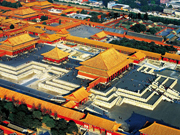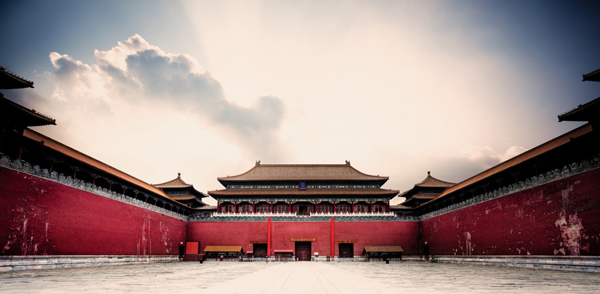Journeying inside the walls of the Forbidden City

 0 Comment(s)
0 Comment(s) Print
Print E-mail CNTV, May 19, 2014
E-mail CNTV, May 19, 2014
As the world marks International Museum Day, CCTV News reporter Fei Ye sits down for an exclusive interview with the person in charge of one of the world's most iconic museums. Shan Jixiang, the director of Beijing's Forbidden City, talks about the challenges the Palace Museum faces, as well as the international exchanges it has engaged in. And, for the first time, Shan addresses some of the misconceptions people have about the museum.
 |
|
Journeying inside the walls of the Forbidden City |
"Your background is in conservation and planning of historical cities and cultural heritage, how did that skill set come into use when you took this position?" Fei Ye asked.
"I came here in 2012. I studied achitecture, but managing the Forbidden City is a very complex task with a lot of challenges." Shan Jixiang said, "Things like security, fire safety, infrastructure, displays, and exhibitions, these must remain our highest focus. Protecting one of the world's most sophisticated heritage sites and the largest wooden complex of ancient buildings that house priceless collections, comes with great responsibility."
"Forbidden city was the imperial court for the Ming and Qing dynasties but people feel it can't really compare to the Taipei Palace Museum's collections. Can you explain this to us?" Fei Ye asked.
"We have a total of almost 2 million heritage collections, covering all categories of ancient Chinese culture including painting, ceramics, bronzewares, jade, gold, silver, furniture and many more. Before 1949, the Nationalists took just 5 percent of the palace's collection, they have much less than we do, but why do people still say that the Museum in Taipei has more artifacts? Well, it's because first we have been establishing our inventory and restoring in the past, which we just finished and just started to put everything on display. Second we are more spread out. It's not just artifacts people come here to see but also buildings and the architecture. There are relics everywhere in the Forbidden City. In Taipei, they only display about 3000 artifacts year round while we display 9000. When people visit the Forbidden City, they usually walk through the central axis from south to north, but you won't cover much through this route. To see the entire palace, it would take more than just one visit. Therefore, in comparison, the Taipei Palace Museum is much more concentrated with all its relics in one place." Shan Jixiang said.
"The seat of supreme power for over five centuries, the Forbidden City in Beijing with its landscaped gardens and many buildings including nearly 10,000 rooms, contain furniture and countless artworks. The priceless collection reflects the richness of Chinese civilization from the Ming and Qing dynasties. Built in 1420, the palace is China's largest and most intact complex of ancient buildings. It's laid out symmetrically along a north-south axis in the center of Beijing, providing insight into the social development of late dynastic China. The well-designed palace appears magnificent, solemn and harmonious, representing the long cultural tradition of China and its outstanding architectural accomplishments. Director Shan took us for an exclusive tour of the old imperial city showing us some of the most valuable works still being restored." Shan Jixiang said.
"We have about 2200 western clocks all from the 17th and 18th century. They were presented as gifts to the Qianlong Emperor. 800 of them are working and 1000 are being restored. Half of the entire collection is from England and the rest is from Sweden, Germany and other countries. We have the world's most valuable and biggest collection of western clocks here." Shan Jixiang said.
"The most difficult part in restoring this clock is that I have to learn about its complex mechanical structure. It's very complicated as there are several fuctions to it. One controlls the time, the other the music and the third the built-in automaton of characters and animals that make the hourly chimes. It will take me 3 to 4 months to finish it and the bigger ones will take half a year." Qi Haonan, Curator of The Palace Museum said.
"Next we made a stop to the furniture conservation department."
"This is a two-part closet from the early Qing dynasty. There are several missing pieces inside the closet, which has been damaged by termites. Minority groups presented it as a gift to the emperor. It's made of rose wood, and the ornaments are decorated with turtle and clamshells, gold, carnelian gemstones and silver. The most difficult part for us in the restoration process is finding the right material similar to the original and people with the right skill sets. We will finish this by the end of the year." Kong Yanju, Curator of The Palace Museum said.
"You have traveled a lot and seen a lot of museums. What are the differences between the western museums and the Palace Museum? " Fei Ye asked.
"Museums in the west were established very early on. They have been part of people's lives for many generations. We have only been around for over 100 years so China is still in the developmental phase. But we are growing very fast, there's a new museum established every 2 days. Our understanding of museums have also been changing. Museums don't just simply provide a place to preserve historical artifacts but it's also an institution for research and cultural education." Shan Jixiang said.
"I know that by 2015, the country is planning to built around 3000 museums. That's a lot but I feel that what's important to people are the details and how they can relate to stories and the history itself." Fei Ye said.
"When people walk out of the museum they will only find a couple artifacts that are very memorable so we need to further develop the stories behind each piece. We have made great progress in many areas. We have the world's most sophisticated audio guides. Many of the best museums around the world only have 10 to 12 langauges and some didn't even have Chinese until recently. But we provide 40 languages covering many dialects. We are also able to adjust the story telling of the audio guides according to each person, for example for children, scholars, and for the general public. It's been really well received." Shan Jixiang said.
"What kind of international exchanges have you had before and how important is it?" Fei Ye asked.
"We have had collaborations with the Metropolitan museum, the British museum and the Louvre. Last year we also signed a deal with the International Council of Museums to establish an international training center at the Palace Museum. We have taken the responsibility for training museum curators and to provide highly skilled personnel for the world's leading museums." Shan Jixiang said.
"What's your longterm vision for the museum? What's your next 5 year plan?" Fei Ye asked.
"We have a saying that we should pass the well preserved Forbidden City to the next 600 years. Why 600 years? Well, because it was built in 1420 and by 2020 the Forbidden City is going to celebrate its 600th birthday. That's when two of our major projects will be finished. One is the 18 year long restoration of the palace buildings, which will allow visitors to access 76 percent of the Forbidden City. The other one is to fireproof and earthquake proof the palace and improve our security system. This way we can provide a much safer, better and enhanced environment for everyone." Shan Jixiang said.






Go to Forum >>0 Comment(s)